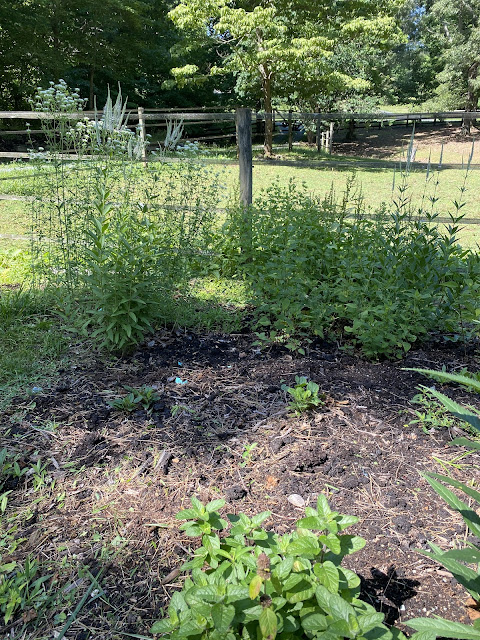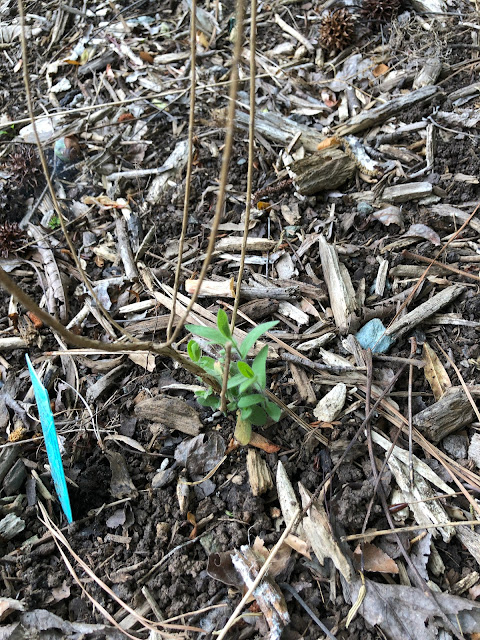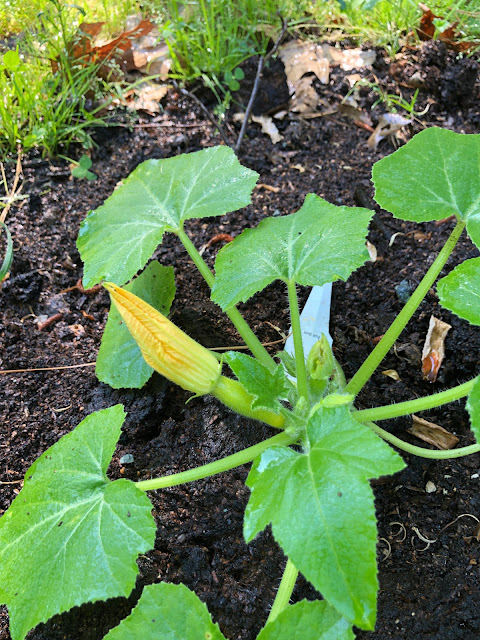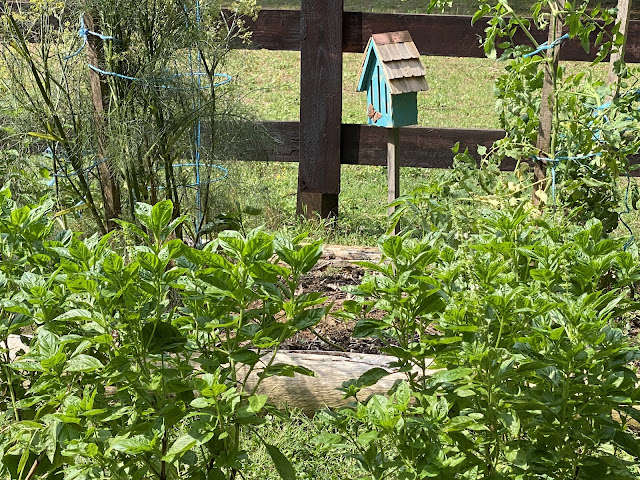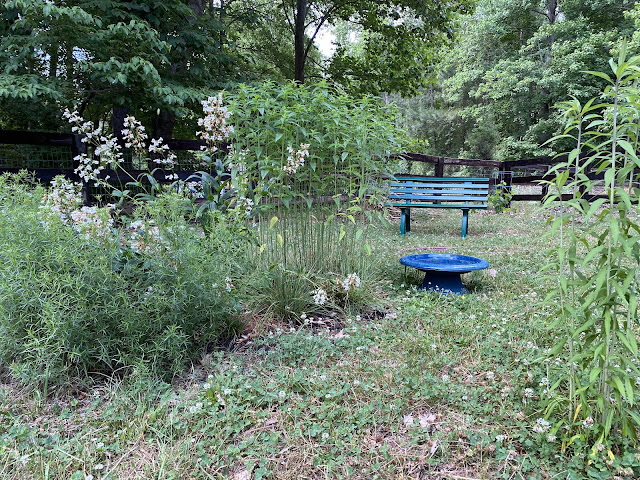Here’s the Big Bay yesterday after being out in the rain for a bit and then drying out, and after his acupuncture and Legend injection. 33 years old and still the King here on November Hill. I salute him. He’s the best horse I could ever have found to be my companion in riding as an adult and now my companion in aging well. He’s doing it better than I am, but he inspires me every day.
Thursday, June 30, 2022
Tuesday, June 28, 2022
November Hill farm journal, 158
Finally, some rain yesterday evening! We’ve been rotating around the farm with hoses, watering any plantings that haven’t been in the ground long enough to develop mature root systems, and of course the vegetable garden.
Another wonderful reason to plant natives is they are generally very drought tolerant after the first year of regular watering.
Even before the rain, things were looking beautiful. The bee balm in this bed is stunning right now.
I’m a little behind in garden chores this week. I still have a fair bit of mulching to do, and weeding, and continuing my work in Poplar Folly. Once again, I’m reminding myself that the goal is not to finish everything, but to have pleasurable, meaningful time working on the things I love. Framed that way, I will never run out of these tasks, right? Sometimes I wonder what it would be like to have been brought up in a culture that places value on the doing of things rather than finishing them in an effort to have nothing to do, a completed to do list, and some intimation of perfection in one’s life because everything has been done and there is nothing left but to gaze upon it.
For me, this requires a shift in what pops first into my mind, and I take that step, always aiming for that step to eventually disappear from my mind altogether.
Today the high on November Hill is predicted at 84. What a relief for all the equines and for us humans working outside! There’s a stiff breeze blowing and everything has been watered by the rain, so from that perspective today’s pleasurable tasks will be less than usual this time of year.
Writing update: I’ve taken a turn this week and have shifted from novel format to TV series pilot episode. I had got a bit stuck and felt like maybe this story is more a visual one than the printed page. I’m giving it a try and we’ll see how it goes.
I tweeted today that I’ve spent every July 4th for the past 20 years sitting with my herd because of fireworks set off by neighbors. I’ll do the same this year, but I’ll wear black while doing it. I’m not happy with the state of our country, with the Supreme Court’s decisions of late, and for all of my life there have been so many things I find wrong about the way this country works. Independence is in my opinion something to be celebrated by the responsibility it brings. None of us is free unless all of us are. Right now the rights of many are being trampled for the rights of a few. I don’t think I’ve ever felt so ashamed our country.
I read a poem this week that encouraged us to be seeds and wait for the water. To plant food and feed ourselves and those who need it. I believe in voting, in being engaged politically, in writing letters and making phone calls. I believe in making our immediate smallest circles, our homes, as peaceful and beautiful as possible for our own pleasure and comfort. I believe in advocating for those people and animals and plants and the planet who need people with louder voices and more privilege to make change happen more quickly than it otherwise might. I also believe that we are all seeds, and that water will come.
Tuesday, June 21, 2022
The Good Boys
Cody is on an exercise regime to get him fit and hopefully back into some riding time as a part of that fitness program, and we started hand walking before his AM and PM feed tubs as a way to begin. He’s up to 16 minutes each time now, and soon I plan to put the saddle on him one of those times and ride. Eventually we’ll probably put the times together into one daily work-out under saddle.
I have been leaving the gates open to the arena this week and I found it remarkably sweet that Redford came and did the walking with us the past two days. He marched every step with us, as if he wanted to keep us company.
Redford stayed with Rafer Johnson at the end of Rafer’s broken leg saga, was a best friend to Salina when she was alive, and then to Keil Bay during his EPM time. He has daily play times with Rafer Johnson, and he gets on well with the pony boy too. Redford is a little more sensitive in personality than Rafer Johnson is, and in some ways more like a horse than a donkey, but the thing I love best about him is that he always seems to gravitate to the equine who needs him.
This is just another example of that in a long line of instances. Thanks, Redford!
And here they are at the end of the exercise:
Friday, June 17, 2022
November Hill farm journal, 157, the bluebird bed
When we moved the grass paddock fence to keep the horses from being right on the driveway when turned out there, we opened up a little space for a fire pit and seating area for us. I also added a small flower bed around the bluebird box we’d moved to its new location.
Some may recall my brilliant plant to put many multi-colored bird boxes on the backyard fence that provides a backdrop to my upper pollinator bed. It looked lovely but our cats were literally sticking their paws through the cracks in the fence to swipe at the bluebird parents as they tried to protect their nests. It quickly became clear that fledging bluebirds could easily fledge right into the back yard with the cats, so we moved it after the final fledging that year and much monitoring to insure no babies were injured or killed.
What I now call the bluebird bed is a sloping area that needed something similar to a rain garden to drink up the water run-off during rain events. In a grander plan that I haven’t worked on yet, my aim is to extend the bluebird bed along the grass paddock fence and eventually meet up with the front walkway beds, with the final goal being to have a large pollinator garden that wraps around the chairs and fire pit.
I’ve learned when creating garden beds out of grassy areas, it’s best (for me) to pick a section and get it going rather than trying to do a more expansive project all at once.
The bluebird bed is beginning to be where I originally envisioned it. This is how it looked after we moved the bird box but before I did anything else. This photo is from the front pasture through the grass paddock, but you can see that the bluebird box has been installed to what was grassy lawn on a slope.
This next photo is how it looked after I prepared the bed and put in the first batch of native plantings. On this area, I used cardboard topped with compost, and after planting, I mulched it heavily. Unlike my main pollinator beds, this one wasn’t given a season to sit. I did it all in a weekend. I think if you have time to give a prepared bed a season before you plant, it’s easier, but I used a garden knife to cut holes in the cardboard for this initial planting.
In hindsight I should have immediately dug a trench around the perimeter of the bed. The grasses are very aggressive and it’s taken a lot of effort to keep grass and other things from moving in. That first year I lost a number of plants to brown bunnies, and added a few things to fill in those losses. Last fall I tried to really fill the bed in and although I lost a few plants to bunnies again, it is starting to look like my initial vision.
As of this morning, I’ve weeded out some of the native plantain that seems to love the area right below this bed. All I can think is that the run-off and slope create an area that the plantain thrives in. Since the plantain is growing inside the front pasture just behind this, it is creeping up and into the bed. I don’t mind a patch of plantain in the front pasture, but I may have to get rid of it in this general area to make life easier with regards to maintaining this bed.
What needs to be done still: fill in a long/narrowish empty strip that is left by some of the bunny munching. It would actually be a great place for a garden sculpture if I had something on hand, or perhaps a strip of stacked stone. I got a newsletter this morning from our feed store saying native perennials have been restocked and oh dear, do I really need to go buy some to fill in this space? Maybe, but I’m going to sleep on it!
Also, it’s impossible to see in these photos, but I have a small grouping of Indian physic in front of the bluebird box that I love. It’s tiny by comparison, but it has such pretty, intricate leaves, stems, and flowers.
Now that the main bed is done, I can add in a few final touches as they come to me. But how nice to walk out and see this bed coming into its glory a bit!
Tuesday, June 14, 2022
November Hill farm journal, 156, a chronicle of the potager
I realized today while in the potager that it has almost reached the initial vision I had of it way back when it was still just the far end of the “dirt paddock” with gates leading to front and back pastures. The gates were attached to the perimeter horse fencing, and in order to go from the barn to either pasture out of the main paddock, the herd had to go through the gates at that very edge of our property.
I wanted a buffer zone between horses and neighbors, and I wanted some screening as well. I don’t know when the idea popped into my head that we could move the gates up closer to the barn, and to get that end zone buffer, I could fence off a section of the paddock and use it for my own purposes. The dogs were tearing up our seasonal vegetable garden in the back yard, and the notion of an outlying potager was born.
This is how it looked the day we had the fencing off of the space done:
It was fairly barren most of the year because of the hoof traffic going through on a daily basis. Once we fenced it off, it began to fill in with various pasture grasses and other volunteers. My goal initially was to let the ground heal from the traffic, and use some cedar pieces we had from a dead tree to create vegetable beds. I also tried to use things we had on hand - old tomato stakes, hay bale twine, etc. I prepared these beds by putting down cardboard, compost, a layer of fallen branches picked up from the pastures, and then more compost. All our compost comes from our “grandfather” manure pile, so we have access to very mature compost almost all the time.
The first year was a simple vegetable garden but we got a huge amount of produce. And when working in the potager, right from the beginning, I often had company.
Redford is shyer than Rafer Johnson, but he has attached himself to me since Salina died and he almost always leaves the herd to come to wherever I may be working when I’m outside. He’s not one for being “snuggled” but his company is very sweet and I get the sense that he would help me if I needed it.
That first year and on to the next, I added things to the potager as I had time. More vegetables, and a few natives. The first two natives I put in were American hazelnuts, one on each of the back corners of the space. My hope is they’ll grow large enough to act as screening and as they mature, will provide some nuts for us. One of my most memorable dinner party desserts one year was raspberries from our garden on top of homemade roasted hazelnut ice cream. I’d love to recreate that with our own hazelnuts one day. One hazelnut thrived the first year and the other seemed to die, but I kept it in the ground through that winter, watered it as if it were alive, and in fact, it was. They are both much larger and doing well. Almost as tall as I am now.
The second year I considered putting one of our bee hives in the potager and placed the empty hive there for a month. I know people keep horses and bees in much closer proximity than we do without any issues, but I kept wondering what would happen if the bees became territorial in the potager. I eventually moved the hive boxes down to our main apiary and as of today, we have 5 thriving colonies, which is another update I will do in the next few weeks.
All the native flowering pollinator plants have done quite well in the potager. I put some African basil and bronze fennel (not natives!) in one of the veggie beds and we had quite a showing of swallowtail caterpillars and chrysalis. They devoured the fennel and the bees love the African basil. Since many of the vegetables we plant for produce are not native, I opted to only plant native flowering plants in the potager instead of using non-native cutting flowers as is commonly done. We enjoy our seasonal vegetable garden and many of our favorite summer meals depend on the fresh from the potager produce we grow. We also belong to a local CSA for a larger variety of vegetables that I don’t make the effort to cultivate.
The third year I added in a few elements that are not living but made the space more appealing and offered a place to sit. I enjoy the space quite a lot. It’s peaceful, so full of growing things, and I enjoy being right in the middle of the horse pastures where the equines are often close by grazing and sometimes lining up hoping I’ll let them in with me.
This year and this week I’m seeing the realization of the potager project. Everything perennial that I’ve planted previously is thriving. We haven’t planted as many vegetables this year, but that will change from year to year depending on our food needs and wants. I have a multi-season variety of native pollinators that bloom in all but the deepest winter months. The potager has become a home to many insects, bunnies, squirrels, black snakes, and birds who seem to enjoy it along with me. It’s a small haven on our little farm.
This year we added a third trellis and have planted blackberries there, and as you see in the photos I allow the grasses and white clover to grow on the parts I’m not yet using. I use a small electric weed-eater to keep them from taking over, but I usually leave a large area undisturbed to provide some cover for any wildlife that needs it. I’ve started a small compost pile inside the potager, incorporating any brush, fallen branches, and the occasional wheelbarrow of manure from the herd. I generally don’t turn the compost piles, as we have so much compost I don’t really need the quicker turnaround that turning offers, but it would be easy enough to do if I wanted to generate compost inside the potager for use there each season.
I’ve included a photo of the one morning this month when the potager was invaded by bandits. In the end, they did no damage, and I feel like they made their own potager dream come true that morning, aided by my forgetting to latch the gate the day before.
There are more things to plant here, of course. I’d love to add an asparagus bed at some point, and I’ll add more native flowering plants, including milkweed to support the monarchs. I have a mason bee house that I need to install, and I have an idea to use some wire panels we have to create a sort of arbor over the bench. A couple of native blueberry bushes might be nice too. As the perennial natives grow, the screening will increase, and eventually it will be even more protected, even more the little buffer haven space I saw in my mind’s eye.
I tend to focus on the things I want to do on the farm, and decided this week to focus at least some energy on updating the things that are mostly completed. It’s nice to go through photos and create albums, then blog posts to chronicle the projects from beginning to end. Though we all know that anything involving living things will grow and change, and I look forward to how the potager will continue that very interesting process. This is one of those projects where I feel very strongly that I’ve made it into something much better than I found it.













